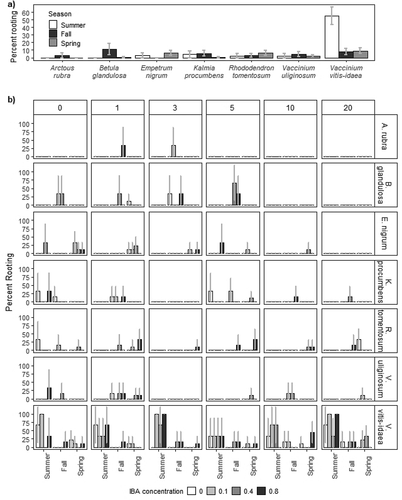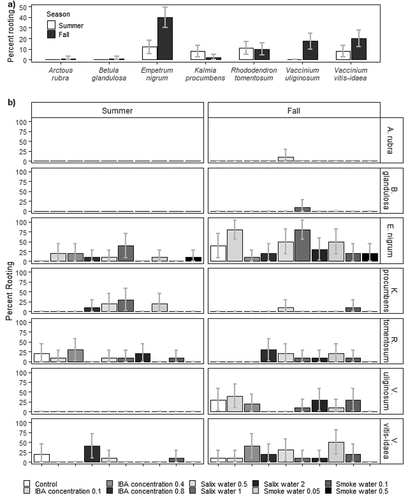Figures & data
Table 1. Species, treatments, and replication for experiments 1 and 2 in different seasons
Figure 1. Percentage of rooted cuttings with 95 percent confidence intervals in experiment 1 for (a) each species (x-axis) grouped by time of year and (b) separated by all treatments; species (horizontal panels), time of year (x-axis), soaking time (vertical panels, zero, one, three, five, ten, twenty days), and growth hormones (0, 0.1, 0.4, 0.8 percent IBA). Summer cuttings of Arctous rubra, Rhododendron tomentosum, Vaccinium uliginosum, and Vaccinium vitis-idaea only received three IBA concentrations (0, 0.1, 0.8 percent IBA). Number of cuttings in (a) and (b) are summarized in .

Figure 2. Percentage of rooted cuttings with 95 percent confidence intervals in experiment 2 for (a) each species (x-axis) grouped by time of year (n = 100) and (b) separated by species (horizontal panels), time of year (vertical panels), and treatment group (n = 10); untreated (control), growth hormone (0.1, 0.4, 0.8 percent IBA), Salix water extract concentrations (0.5, 1, 2), or smoke water extract dilutions (0.05, 0.1, 0.5). Arctous rubra and Betula glandulosa were only collected in fall.

Table 2. Number of cuttings with primary, secondary, and tertiary roots for each species and location of roots on cuttings
Figure 3. Length of longest primary and secondary roots at day 60 with 95 percent confidence intervals for rooted (a) Empetrum nigrum, (b) Rhododendron tomentosum, and (c) Vaccinium vitis-idaea cuttings in experiments 1 and 2 at different times of year. Number of rooted cuttings is summarized in and Supplementary Table 1.

